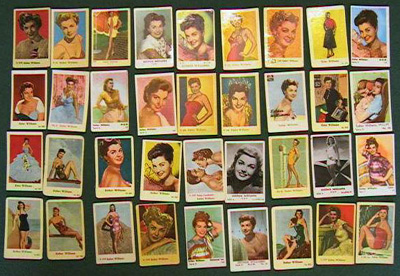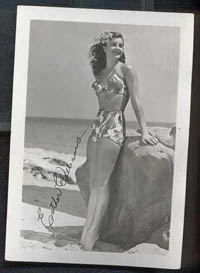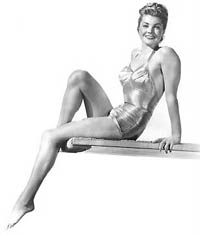USS Floyd B. Parks DD-884
 "The
Fightin' Floyd B"
"The
Fightin' Floyd B"

Return to Menu
|
ESTHER LIVES ON
An inquiry by our President Tom Pelton in our JulyAugust-September issue of Tin Can Sailor, regarding the Esther Williams Pennant and Esther Williams Trophy triggered a lot of memories. The fact that Tin Can sailors are asking about it is frightening to me as it brings home the realization that those of us who fought for the Esther Trophy are declining in numbers. It would be a shame to have the tradition pass away with us, as it was very much a morale builder to the officers serving with the post WWII Asiatic Fleet in the late 1940's and 1950's. I participated in the battles for Esther when officers of the wardroom of the Floyd B. Parks (DD-884), and one from the staff of Commander Destroyer Squadron 1 which was embarked in Parks, "seized Esther" by "Fair Means and Foul", from his Majesty's Australian Ship (HMAS) Shoal Haven. It happened in Sasebo, Japan on 18 February 1950. Yes, the Australian and British destroyers on Far East duty shared Esther with us. Before I proceed with the background on Esther, let me say that a couple of Esther adventures have been published before. Captain Daniel M. Karcher, USN (Ret) wrote an account of the first Parks foray to seize Esther in the July 1986 issue of U.S. Naval Institute Proceedings, pages 115-116, "We've Come For Esther." It was an excellent account of the battle, but it did not mention all of the Parks officers involved, nor do I agree completely on the sequence of events. The third and fourth articles can be found in the September 1990 issue of the Institute Proceedings. The first, "My Affair With Esther" by Captain William C. Green, USN (Ret), and the second "More About Esther" by Lieutenant Commander Robert Irving, USN (Ret). What horrified me about these articles was that the ships involved were the USS Boxer (CV-21) and the USS Lexington (CVA-16), and also the USS Philippines Sea (CV-47). My god, wardrooms on the ships the size of carriers battling in hand-to-hand combat over Esther, that could be devastating! If any of our readers are interested in these accounts mentioned above, I would be glad to photocopy them for the cost of postage and envelopes only, if contacted through Tin Can Sailor. When Esther originally started, it was limited to destroyers on duty in the Far East. All that time the Type Command was COMMANDER DESTROYERS PACIFIC FLEET (COMDESPAC). When the cruisers were incorporated, the Type Command became (COMMANDER CRUISERS DESTROYERS PACIFIC FLEET (COMCRUDESPAC). It was at this time that cruisers began competing for Esther. I suppose it was inevitable that the aircraft carriers would horn in. There are several versions of how the Esther tradition got started in the fleet, and probably there is some truth in all of them. Regardless of how it happened, it was one of the finest morale builders in the Asiatic Fleet from the late 1940's through the late 1950's. Was Esther Williams aware of this adoration? You bet! The Parks wardroom corresponded with her and she mailed us a beautiful picture of herself in a print bathing suit signed, "My regards to all the fellows on the USS Floyd B. Parks, Esther Williams. One version says the legend of Esther started during WWII on board an Australian ship. A young officer who constantly mooned over this photo was due to be transferred. His mates, not wanting to lose the picture, stole it. The other version was that the officers purloined the picture just to vex this star-struck youth. These versions are the ones that appear in Captain Green's article previously mentioned. The version I like best is that told on the Parks. During the early occupation days in 1945-1946, the picture of Esther had been stolen from the cabin of an officer who claimed to be her fiance. The loving inscription on the picture itself would tend to support this claim. At any rate, the officer raised such a ruckus getting the picture back that others joined in the fun of stealing her picture. Thus, a game developed among officers of the occupation ships - stealing the picture from whichever ship happened to have it. I suppose it really does not matter how the Esther tradition began. The important thing is that it was there for the ships on occupation duty at the right place, and right time. It furnished an outlet for a lot of pent-up energy. The implements of the Esther tradition were simple. They consisted of four items. There was the framed "trophy" picture of Esther Williams that was the ultimate prize. There was a duplicate of this picture known as the "fighting copy." This was the copy that had to be captured and would take the beating of physical combat and heavy abuse, such as jumping over the side in saltwater (which we did) and swimming to a waiting boat while escaping with the fighting copy. The fighting copy was encased in plastic so that it could endure substantial abuse. Once the fighting copy was in your possession, the ship having the trophy copy was required to surrender it to the sister ship. Besides the two pictures, there were two other important items. One was the set of rules and regulations that governed the contest. A ship that had Esther was required to have these posted in the wardroom. The other was the Esther Pennant. The ship that had Esther on board was required to fly this pennant at all times when in port. This was an open challenge to all destroyers saying, "We have Esther, come and get her if you can." Also, when entering port, the ship carrying Esther was entitled to send a message to all ships present, announcing her presence on board and inviting one and all to come, look, and admire, but not touch. Forward: The Rules and Regulations for capturing Esther was straight; 1. The "Fighting Copy" was to be displayed in the wardroom at all times, free and clear on a wardroom bulkhead and not secured in any manner; 2. Esther could be captured by stealth, guile, brute force, and by fair means or foul; and 3. When a ship had captured the "fighting copy" of her picture, the ship having possession of the trophy copy was required to deliver up the trophy copy together with the Esther Pennant and the rules and regulations within twenty-four hours.
My personal experience with Esther can be briefly related and it is one of my fondest memories of serving on destroyers. My ship, the USS Floyd B. Parks (DD-884) was on occupation duty with DesDiv-11, operating out of Sasebo, Japan. The other ships in the division were the USS Orleck (DD-886), the USS John R. Craig (DD885), and the USS Brinkley Bass (DD-887). The Parks was the flagship of Commander, Destroyer Squadron One, Captain Walter C. Winn, which consisted of DesDiv-11 and DesDiv-12. However, in those days the destroyer operating unit was the division and DesDiv-11 and DesDiv-12 were never together. Before the Korean War started in June of 1950, tensions between Japanese and Korean fishermen had reached a dangerous pitch. In order to keep the two sides apart, General Douglas MacArthur mandated areas in which each country could fish. He established a line that ran from the island of Saishu To in the East China Sea off the tip of South Korea, through Tsu Shima and into the Sea of Japan. This line dividing up the ocean between Japan and Korea became known as the "MacArthur Line" and fishermen from either country could not cross it and fish in the other's waters. These waters are shown as the Tsu Shima Straits on mariner charts. Our job at the time was to keep the peace by patrolling this line. The Parks would leave Sasebo and proceed northeast into the Sea of Japan leaving Tsu Shima Island to Port and the main Japanese islands of Kyushu and Honshu to starboard. After a couple of days we would turn east toward the coast of Korea, then southeast passing very close to the coast of South Korea to starboard. We would again pass Tsu Shima Island to Port, and continue to the island of Saishu to off the tip of South Korea. We would then turn east and steam back to Sasebo. We had thus completed a patrol around Tsu Shima in a giant counter-clockwise circle. Because of the route around Tsu Shima Island, this became known as the Tsu Shima Patrol. On returning to Sasebo, the sister ship in our section the John R. Craig (DD-885), would debrief us on our trip, and then sail the next day on the same patrol, only this time taking a clockwise direction around Tsu Shima Island on the reverse direction of our patrol. After several patrols we would be relieved by the other ships in the division, the Orleck (DD-886) and Brinkley Bass (DD-887). We would then sail to the liberty ports where they had been, namely Nagasake, Kagoshima, Nagoya, and Yokosuka. The account I am about to record on the Parks' Esther raid varies from that related by Captain Karcher in his article "We've Come For Esther" that appears in the US Naval Institute July 1986 issue. My account is not only written from my own memory on the sequence of events, but also is the same as that which appears in our "Log of Cruise 1949-1950, USS Floyd B. Parks." This was our cruisebook for the long deployment when the Esther capture occurred, and was written at the time it happened. I have checked with another officer who participated in the raid, and he agrees with the version I am about to relate as the correct sequence of events as he remembers them. I do not suppose it really matters as the final result is the same, we ended up with Esther. I might also add that the following incident was not the only time the Parks captured Esther. In the fall of 1965, in an assault led by LCDR Daniel Banks the Parks captured the Trophy from the Canadian Frigate HMCS Frazier. On 18 February 1950 the Parks was in Sasebo Ko with the HMAS Shoal Haven. The Parks wardroom officers played a rather strenuous softball game that Saturday afternoon in the course of which there was some discussion as to whether Shoal Haven could hold Esther against an assault by Parks. After a brief exchange of dispatches with Shoal Haven, they knew they could stand by for a raid that same Saturday night. The Parks' assault party consisted of Lieutenant Daniel M. Karcher, Parks Executive Officer; Lieutenant Arthur T. Emerson, Staff Communications Officer; Lieutenant "Joe" Francis B. Busch, Engineering Officer; Lieutenant (JG) Harold A. Bres, Jr., Operations Officer; Ensign Paul E. Trejo, Gunnery Officer-, Ensign Robert M. Weidman, Jr., Communications Officer; and Ensign Albert Gleaves Cohen, the ASW Officer. Not all of the Parks' officers participated in this raid, but as it turned out, the ships were evenly matched. The Shoal Haven, which was a frigate and a smaller ship had fewer officers. By using her entire wardroom in defense of Esther, the numbers were evenly matched. The attack plan was simple. Ensign Bob Weidman had been invited to Shoal Haven for dinner. He was in position to seize the picture from the inside when the assault began. The Parks and Shoal Haven used a common liberty boat from Fleet Landing., delivering the Parks sailors first, and then proceeding to Shoal Haven. When the VP liberty boat came alongside Parks, the raiding party piled into the bottom of the boat. Art Emerson and myself stood in the boat, wearing white hats and trying to look like some of the returning liberty party, in spite of the beat-up khakis we were wearing. The British sailors in the boat thought we were crazy, but they ignored us sensing something was up. The ruse worked perfectly.The Parks raiders stormed up the gangway and seized the officer of the deck. As we began to tie him up, the deck watch drew his pistol in a threatening manner. The OOD whom we were securingwas screaming, "Put the gun away, it's OK!" The time was about 2300 when we rushed into the wardroom shouting "We've come for Esther!" A general melee began with wrestling matches all over the wardroom. Tables and chairs were overturned, plates and glassware went everywhere and the wardroom was in general, destroyed. At some point the wardroom door burst open and the Shoal Haven watch guns at the ready, rushing in to investigate the commotion. Luckily, the Shoal Haven executive officer was able to convince them that it was okay, all in fun, and back we went into the fray. A glass covering on a coffee table was shattered and some blood was splattered on the fighting copy of Esther, which by this time was being tossed around between the officers. Whose blood it was is not certain, as several people were cut by the glass. After the battle was over one of the inscriptions that was written on the back of the fighting copy was "Human (Wardroom) blood. We aren't sure whether it's Shoal Haven or Parks, but it's blood. Must be "Parks" as it's all blue." After about an hour of heavy combat (or two hours depending on who you as N Joe Busch of Parks got possession of Esther's picture and stuff~lit under his jacket. He then struggled out of the pack, dashed out of the wardroom, raced to the fo'c'sle (forcastle) and dove into Sasebo Harbor, where he was picked up by a Parks circling whaleboat. With Esther gone, the Shoal Haven's wardroom, now a complete shambles, and all hands completely exhausted, a truce was signed and the trophy copy of Esther given to the Parks. The battle worn contestants then sat amongst the debris of what had once been a beautiful wardroom, and drank Australian Blackberry Brandy. The victory was celebrated with a party Sunday aboard Shoal Haven, followed by dinner in Parks' wardroom Sunday noon. Unfortunately, Esther's stay on the Parks was very short. About a week after our victory over Shoal Haven, three officers from our sister ship Orleck, ostensibly on ship's business, slipped into our wardroom and stole Esther without lifting a finger. Her departure wasn't even noticed until the evening meal. An attempt to retake Esther was subsequently made. When this actually occurred is in question. The ship's cruise book says it occurred that same afternoon, that the Orleck stole Esther from us, which was in February. Captain Karcher's account places it much later, just before we departed for the United States in mid-May. I do know it did happen, because I got soaking wet by being tossed overboard from Orleck. The players this time were Lt. Emerson, Lt. Busch, Lt. (jg) Bres, Ens. Trejo, Ens. Weidman and Ens. Cohen. New faces in the line-up were Ens. Albert Bailey Hallman, Assistant Engineering Officer and Ens. Marvin S. Hutchinson, the ship's Supply Officer. Our fearless Executive Officer, Lt. Karcher was making plans for going to sea and did not participate. That morning we boarded the Orleck in the Guard Mail boat using it as cover. Our raiding party was quickly detected and destroyed before we could get near the wardroom. One by one we were subdued and thrown off the quarterdeck into the frigid waters of Sasebo Harbor. Fortunately, our whaleboat was standing by to pick us up, otherwise it would have been a long, cold swim back to the ship. The Parks set sail for San Diego on 20 May 1950 arriving in San Diego on 7 June 1950, having sailed from there in October 1950, a cruise lasting nine months. The Korean War broke out on 21 June and the Parks sailed on 28 June with a Task Force for the Far East. It is only fitting to close this story of Esther with a poem for her by THE GREAT BARD who was really Lt. Art Emerson.
LOVE'S LABOR WON or (They've Had It) Seven Parks did a wooing go, Esther's hand to gain. By force they went aboard Shoal Haven one black night midst rain. Quickly tieing the O.O.D. They crashed into the wardroom; Then fighting elbow, hand and kneeGreat Guns! they lowered the boom. The battle raged o'er chairs, through doors, No quarter asked nor given; As speaks the blood upon the floors We had successfully striven. To say both sides did fight with vim Would be to underestimate. Their purpose being never dim, The highest praise they rate. For when a lady's favor is at stake, The conflict ne'er will end, Until without a doubt, you make Her smile and condescend. Now she's in her champion's home, Aboard the Floyd B. Parks. She's happy here and will not roam; You see, we've made our marks. THE GREAT ( ? ) BARD (Lt. Art Emerson) 21 February 1950 USS FLOYD B. PARKS (DD-884) Sasebo, Kyushu, Japan |


